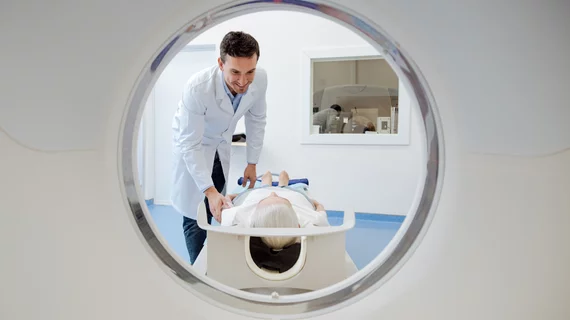No gadolinium required: New take on old MRI contrast shows positive results
Researchers from the University of Texas at Dallas have revived an old MRI contrast agent using a novel method that safeguards the material during its journey through the body.
The technique essentially attaches the injectable material to a plant virus and wraps it in a protective chemical "cage," according to a study published Feb. 5 in Chemical Science. With no gadolinium or heavy metals required, this organic agent may have just found new life, corresponding author Jeremiah Gassensmith, PhD, said in a university news item.
“Everything we are using has been tested or part of medical research for decades. We just put them all together in a new way,” said Gassensmith, a professor of biochemistry at UT Dallas. “We have some more work to do to show that our material is stable in the complex environment of the human body, and we’d like to see whether we can target it to specific diseases such as cancer and other abnormalities in tissues."
Organic radical contrast agents have been tossed aside because they are easily broken down in the body by vitamin C and aren’t bright enough to use during MRI scans. ORCAs, as they are known, are also biodegradable, making them popular among patients and researchers.
For the first step of their study, Gassensmith and colleagues attached ORCA molecules to thousands of individual locations on a tobacco mosaic virus.
“Since this is a plant virus, it can’t infect people or animals, and it’s easily broken down by the liver,” he said. “Because the virus is so large, it also allows us to put thousands of the ORCA molecules right next to each other. It’s the difference between having one Christmas tree light, which is pretty dim, and a whole string of them together, which is quite bright.”
And to protect it from being broken down in the body, they put the organic agent in a “cage.” These hollow chemical structures and ORCA molecules stick together without forming a chemical bond. The design allows water to interact with the contrast, a crucial function required to create MRI scans.
Upon injecting the caged version of ORCA in mice, the material offered more than two hours of visibility, compared to the 30 minutes using unprotected organic contrast.
More research is needed, the group wrote, and the material must be tested in human subjects before they can determine its true effectiveness, but the initial findings are encouraging.
“…I think our results are a promising step toward developing supramolecular ORCAs into clinically viable contrast agents,” Gassensmith wrote.

